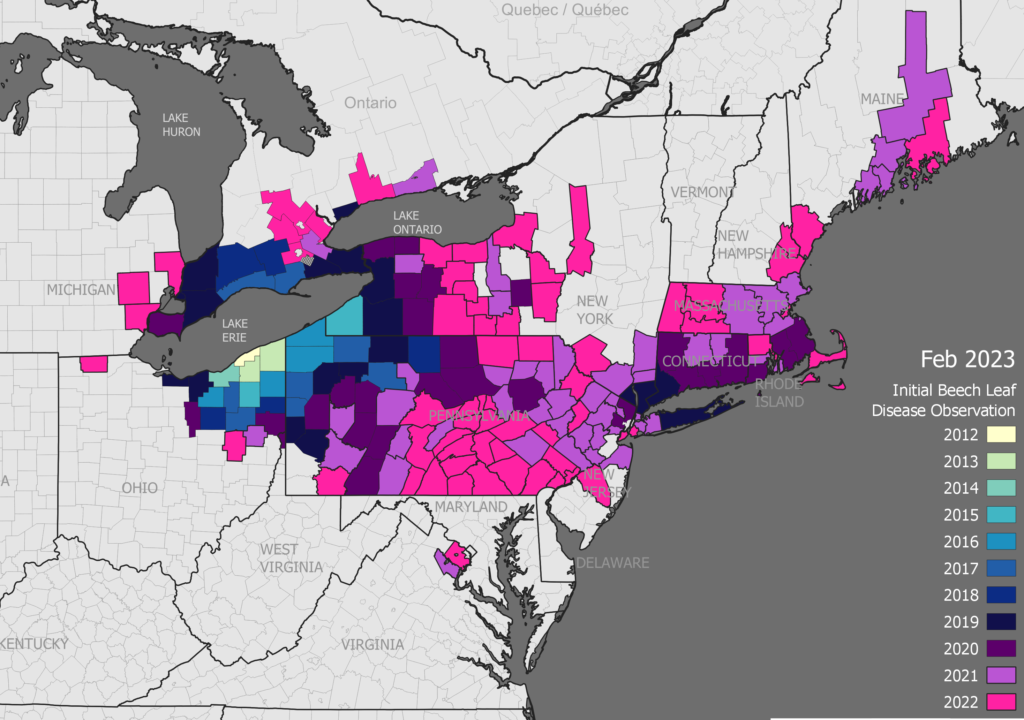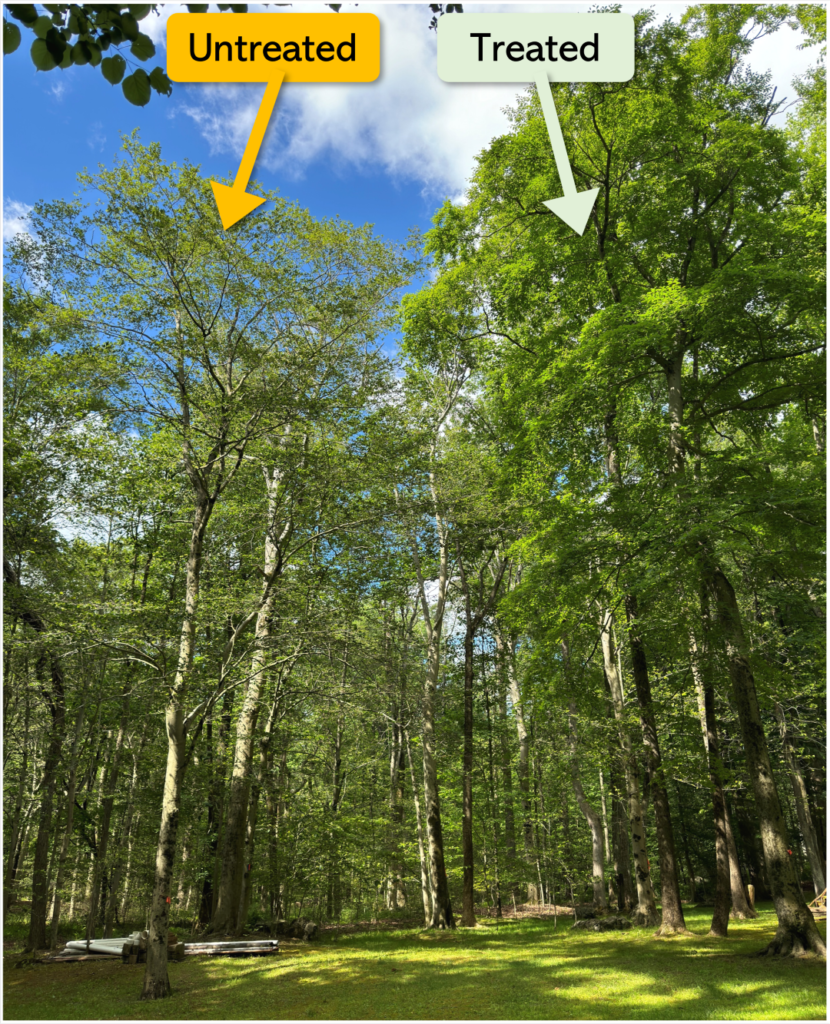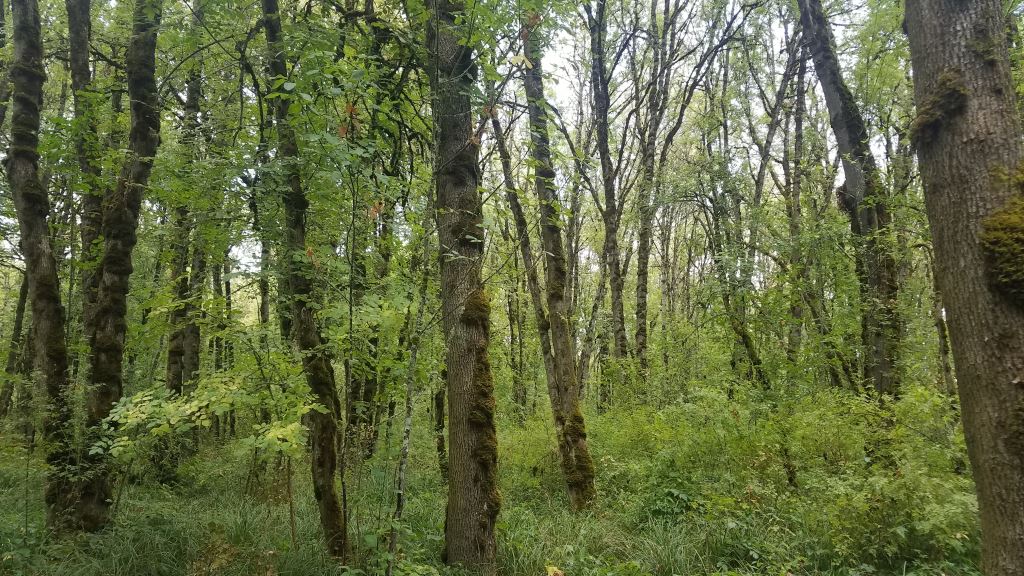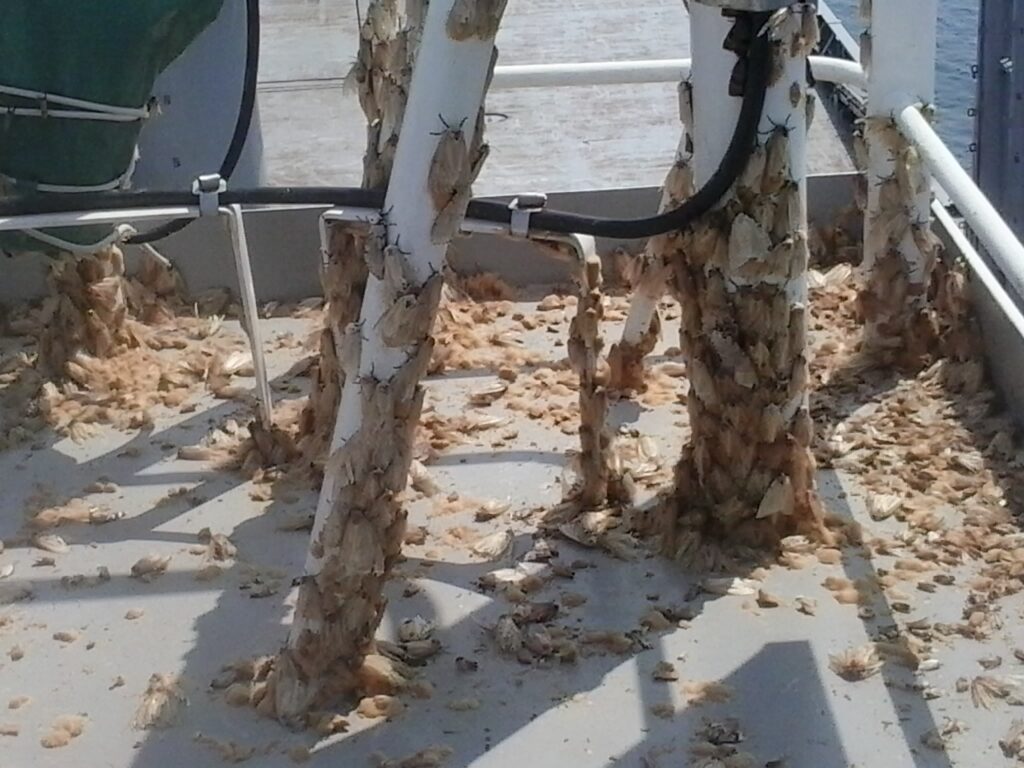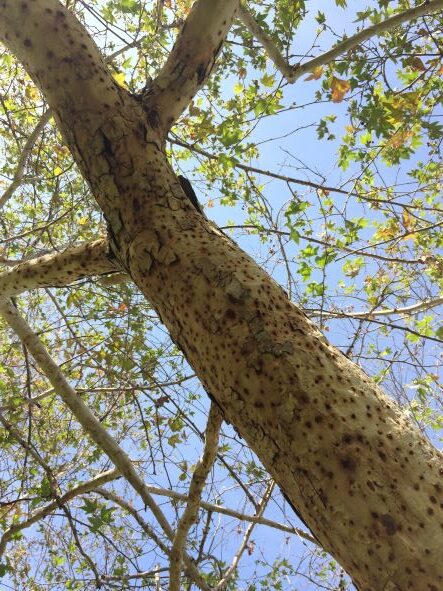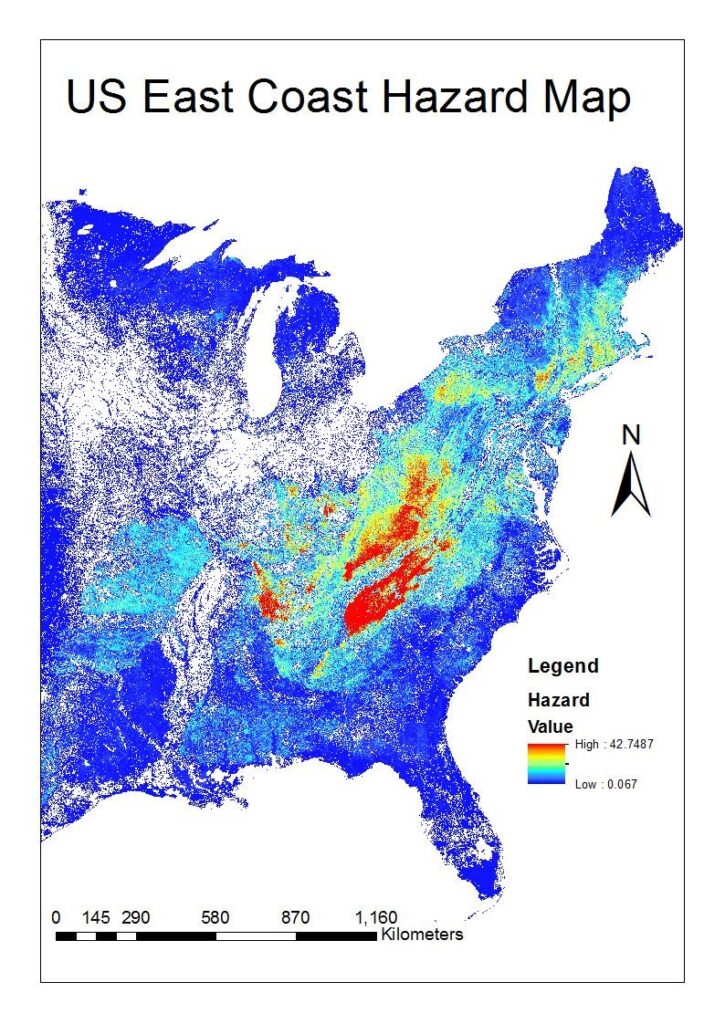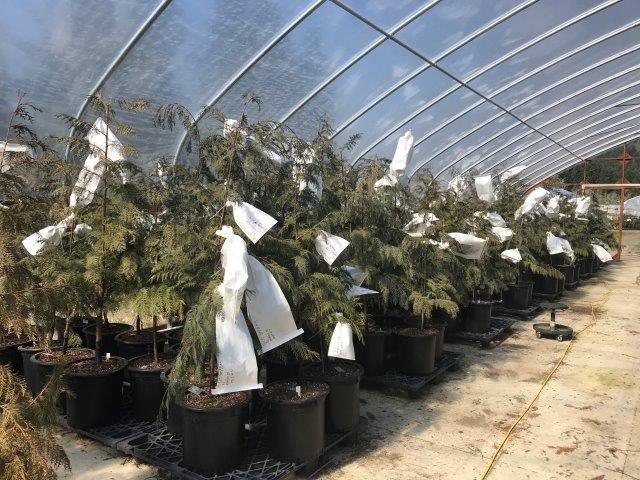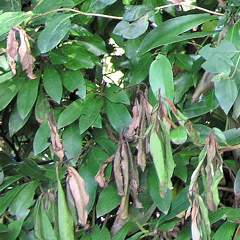I am belatedly catching up on the situation with regard to Phytophthora ramorum – sudden oak death – in the US and other countries.
For a general factsheet on this plant disease, see profile here. Here, I’m summarizing more detailed information contained in the February, May, and August 2024 newsletters of the California Oak Mortality Task Force (COMTF) (Newsletters for earlier months are posted here.)
To obtain the most recent information, you can attend the Fall 2024 virtual meeting of the Task Force on Tuesday, October 29, 2024, from 1 pm to 3 pm PDT. Speakers will focus on the status of P. ramorum in California and Oregon wildlands.
On the next day, Wednesday, October 30, the Phytophthoras in Native Habitats Work Group will discuss “Threats to California Native Plants” including from viruses and excessive heat, along with other concerns.
Participation is free, but registration is required. Complete agendas and more information will be available soon here. Sessions will be recorded and posted to the same site. Questions? Contact Janice Alexander.
More in-depth information à Matteo Garbelotto’s UC Berkeley class, “Ecology and Impacts of Emergent Forest Diseases in California,” is now available free and online. Recommended reading, lecture recordings, slides, even essay topic suggestions are posted. Subjects covered include several high impact forest diseases, molecular diagnostics, disease control, and prevention.
I note that the recent detections of new outbreaks in forests and nurseries support the importance of weather in promoting or hindering establishment and spread of Phytophthora ramorum.
Phytophthora ramorum in North American Forests
In Oregon, P. ramorum continued to spread in 2023 and the first half of 2024.
These outbreaks were detected through extensive surveillance. Aerial monitoring (in cooperation with the USDA Forest Service) and high-resolution imagery covered more than half a million acres in Curry County — the region between the California border and the Coos County line. Ground surveys covered 860 acres. Sampling included 518 trees; 117 tested were positive for the fungus. Stream baits were deployed to 63 sites; 26 tested positive at least once (COMTF newsletter, February 2024; includes maps).
By summer 2024, 23 new P. ramorum infestations had been detected at or beyond the Generally Infested Area (GIA; the area where the pathogen is most commonly found) since 2021. Some of these involve one of the newly detected clonal lineages. Oregon officials are expecting to expand the state’s quarantine area to 901 square miles – 45% of Curry County. The designated GIA would also be enlarged to 178 square miles(COMTF newsletter, August 2024; contains maps).
Oregon continues trying to treat high-priority infestations. In 2023, the state treated 165 acres infested by one of the newly detected clonal lineages, NA2, in the Humbug Mountain area and 347 acres in the Port Orford infestation. Since 2001, Oregon’s Department of Forestry has completed eradication treatments on more than 9,000 acres at an estimated cost of over $37 million. Federal lands comprised 28% of treated acres; the remainder were private and state lands. Still, more than 1,000 high-priority acres have not been treated because neither state nor federal agencies could provide sufficient funds (COMTF newsletter, February 2024).
The stream baiting program in 64 stream drainages has – so far – detected six positive streams. Ground surveys are planned for the new positive drainages along the north bank of the Rogue River and a stream that drains into the Elk River east of Port Orford (COMTF newsletter, August 2024).
In California, recent wet winters have prompted several new detections. The first was in Del Norte County near previously detected sites. The UC Berkeley-coordinated “SOD Blitz” plans intensive surveys in this region in coming months (COMTF newsletter May 2024; contains map).
Somewhat later, new infestations were detected farther south, in Humboldt Redwoods State Park. The new sites were outside the formerly detected sites, on the north side of the creek and up to the top of the ridge (COMTF newsletter, August 2024).
Scientists have realized another concern: several other pathogens cause symptoms on bay laurel, tanoak, and madrone that are almost indistinguishable from SOD. This development will complicate monitoring (COMTF newsletter for August 2024; see below for more details).
Meanwhile, scientists determined that sites where the P. ramorum epidemic is driven by higher bay laurel (Umbellularia californica) densities sustained a higher genotypic diversity of P. ramorum. While tanoak (Notholithocarpus densiflorus) doesn’t contribute much to infection of true oaks (Quercus spp.) it can infect bay laurel, thus perpetuating the infection. Infected oaks and tanoaks maintain host-specific pathogen genotypes (Kozanitas et al. 2024)
The USDA Forest Service program that monitors streams in the East to detect P. ramorum placed baits in 63 streams in 10 eastern states: Alabama, Florida, Georgia, Illinois, Maryland, Mississippi, North Carolina, Pennsylvania, South Carolina, and Texas. In 2023, positive findings for P. ramorum were detected from two streams in Alabama, and one each in Mississippi and North Carolina. All sites are associated with nurseries that had previously tested positive for P. ramorum. Over the last five years – since 2019 – eight streams in four states have tested positive at least once: five in Alabama, and one each in Mississippi, North Carolina, and South Carolina. The detection in South Carolina is new. Vegetation in the watershed has been sampled multiple times; all samples collected so far — plant, soil, and run-off water – have been negative. The pathogen belongs to the NA1 lineage – the one established in forests in West Coast states. [COMTF newsletter February 2024]
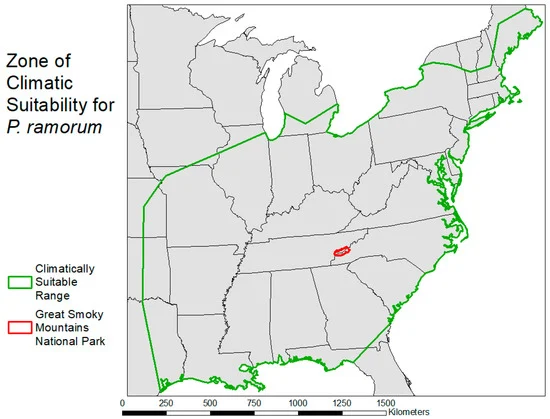
Situation in Europe
The February 2024, the COMTF newsletter summarized the situation in Great Britain. In England, aerial surveillance covered more than 31,000 ha of larch (Larix kaempferi)plantations. Follow-up investigations detected considerably fewer infested sites than the approximately 200 detected in 2022. Most remain in the southwest and northwest of the country. Weather conditions in 2023 were less conducive for sporulation in 2021 and 2022, which seemed to lead to a reduced level of disease in 2022 and 2023.
In Scotland, widespread aerial and ground surveillance detected a number of sites similar to those found since 2018. Scottish authorities note that where positive findings are not quickly followed by tree removal, localized spread occurred.
In Wales, four helicopter surveillance flights identified around 150 sites deserving further investigation. About 60 of these sites held infected trees, mainly larch, but some noble fir (Abies procera). The COMTF newsletter contains a map showing infested locations. This year’s infection level might be less than in previous years, but this might reflect the fact that the infections are in smaller forest blocks. However, the wet and mild weather in autumn/winter 2023 provided optimal conditions for sporulation, so the scientist expected higher infection rates in 2024. The Welsh Government is working on a new strategy for managing P. ramorum.
In Northern Ireland, P. ramorum was described as still active and spreading. Only two surveys were flown. They identified 49 locations for follow-up, many in forests where the pathogen had been found previously. At two locations, follow-up inspections and sampling of larch confirmed infection by a different pathogen, Phytophthora pseudosyringae. So in 2024, larch samples will be tested for both P. ramorum and P. pseudosyringae.
Other Phytopthoras in Europe
English scientists are trying to determine how damaging P. pseudosyringae is on larch. Infections have been observed at several locations in the north of England, as well as in Northern Ireland (COMTF newsletter February 2024).
Mullet et al. (2024) report that P. pseudosyringae is a self-fertile pathogen of woody plants, especially tree species in the genera Fagus, Notholithocarpus, Nothofagus and Quercus. It is found across Europe and in parts of North America and Chile. Genetic studies show that the North American population originated from Europe. P. pseudosyringae can infect roots; the stem collar region; bark; twigs and stems; as well as leaves. They report it is causing particular damage in Great Britain and western North America. Mullet et al. call for investigation of differences in life history traits between the two main population clusters, including their virulence and host ranges.
Chile (COMTF newsletter May 2024)
Concerned about decades of mortality of Nothofagus trees in native forests in Chile, González et al. 2024 sought to understand which other native plants might be reservoirs of inoculum of the pathogen Phytophthora pseudosyringae — which is a documented causal agent of partial defoliation and bleeding cankers on two native tree species, Nothofagus obliqua and N. alpina. P. pseudosyringae can sporulate on lesions on Cryptocarya alba, Nothofagus dombeyi and N. obliqua leaves. On Sophora macrocarpa, sporulation occurs on both asymptomatic tissues and on lesions. S. macrocarpa is a common understory species in Nothofagus forests, so it might be an inoculum reservoir for epidemic events in them.
Look-alikes on California Bay Laurel (COMTF newsletter May 2024)
Similar symptoms from a wide variety of pathogenic organisms were detected on bay laurels after last year’s wet winter. Among the pathogens — the list is not exhaustive — includes P. cinnamomi, Neofusicoccum nonquaesitum, Ganoderma brownie, P. pseudosyringae, P. nemorosa, Botryosphaeria dothidea, Armillaria gallica, Diplodia corticola, and others.
Foliar symptoms tend to look identical on bay laurel leaves. Two foliar pathogens cause particular concern. The first is an “anthracnose” disease of bay laurel caused by a species of Kabatiella. Although known to be present for ~80 years, this organism did not seem to cause problems until 2023. In multiple locations around the San Francisco Bay area, it has caused extensive browning defoliation of bay laurel crowns. Whether the trees will die is uncertain.
The second focus is on a recently named species, Calonectria californiensis. This organism produces P. ramorum-like similar symptoms on a wide variety of native plants, including bay laurel, tanoak, salal, mock-orange, Oregon-grape, and rhododendron. On most of these plants this fungus causes black spots that can grow to kill entire leaves, but apparently C. californiensis is not a pathogen of woody plant parts. Initial symptoms of infection on bay laurel appear identical to those caused by the SOD pathogen (Phytopthora ramorum). C. californiensis does not appear (yet) to lead to lasting debilitating disease or tree mortality.
Nurseries and Managed Landscapes
In administering APHIS’ cooperative program aimed at minimizing spread of P. ramorum via interstate trade in plants, California’s Department of Agriculture (CDFA) relies – at least in part – on funds from USDA. CDFA received $1,308,771 from APHIS in 2023. More than 300 establishments in California are regulated under the program. They submitted ~ 7,400 P. ramorum regulatory samples to the CDFA in 2023. Seventy-eight of the samples were positive (COMTF newsletter February 2024).
At the end of 2023, seven California nurseries that had tested positive for the presence of P. ramorum were operating under the APHIS regulation governing positive nurseries. This was an increase over previous years; zero in 2022, three in 2021 (COMTF newsletter February 2024 Table 4). During 2024 five nurseries were confirmed as positive. Three of these had tested positive in previous years. Two retail nurseries were newly positive; one of these was apparently infected when it brought in plants from another nursery (COMTF newsletter August 2024). I wonder whether the very wet winters California has experienced lately have enhanced the pathogen’s ability to grow – and be detected.
In Oregon, in 2023 the Department of Agriculture regulated five interstate shippers under federal compliance agreements and a sixth intrastate shipper regulated under state requirements (COMTF newsletter February 2024). Spring compliance surveys tested 1,228 foliar samples; ten were positive. After this nursery incinerated all nearby plants, none of the 1,664 foliar samples tested in the fall was positive.
In 2023, the Washington State Department of Agriculture processed more than 300 plant, soil, and water samples; all were negative. Washington also inspected five of the nine nurseries that had ‘opted-out’ of the Federal program so they can no longer ship interstate. Host material appeared free of symptoms so no samples were collected (COMTF newsletter February 2024).
Washington nurseries and regulators frequently encounter the problem of infected plants being shipped into the state from outside. (P. ramorum has been found in 33 Washington nurseries since 2003.) During 2023, the Washington State Department of Agriculture conducted three trace-forward investigations. Fortunately no infestations were detected (COMTF newsletter February 2024). In March 2024, Washington faced another trace-forward involving plants sold to homeowners (COMTF newsletter May 2024). Thirteen tissue samples and two soil samples all tested negative (COMTF newsletter August 2024)
Finally, Washington conducted stream baiting. In 2023, none of the 66 samples was positive (COMTF newsletter February 2024)
Infested Plants
Most of the plant species on which P. ramorum was detected during these years are the usual ones: Rhododendron, Viburnum, Pieris, Arbutus, Prunus, Camellia, Loropetalum. I think the several Cornus species might be somewhat unusual. Disease was confirmed on a new Cornus species, C. capitata (evergreen dogwood). One taxon — Arbutus x ‘Marina’ — is not yet listed by APHIS as a host because Koch’s postulates have not been completed (COMTF newsletters for February 2024 and August 2024).
Research (summarized in the February 2024 newsletter)
Two studies found evidence of seasonal and weather factors influenced establishment of P. ramorum. One study found a clear seasonal pattern of pathogen incidence in the western US, plus a link to the El Niño-Southern Oscillation (ENSO) (Xuechung et al. 2024. The second study looked at a Japanese larch plantation in Scotland (Dun et al. 2024).
In both Scotland (above) and France (Beltran et al. 2024 2024), scientists demonstrated that prompt action helps to suppress P. ramorum establishment.
APHIS Updates its Regulations
In March 2024, APHIS revised the P. ramorum “Domestic Regulatory Program Manual.” The agency said it updated figures and definitions, clarified operational steps, and revised the Retail Nursery Dealer Protocol (COMTF newsletter for May 2024).
Funding
In Fiscal Year 2024, under the Plant Protection Act Section 7721 program, APHIS funded $1 million worth of projects focused on P. ramorum and related species. This was out of a total $62 million in funds dispersed for pest survey, research, mitigation, and outreach programs. This money funded nursery surveys in 11 states. Also, it paid for a project to evaluate the threat of the NA2 & EU2 lineages to nurseries and forests (COMTF newsletter May 2024).
SOURCES
Beltran, A.; Laubray, S.; Ioos, R.; Husson, C.; Marçais, B. 2024. Low persistence of Phytophthora ramorum in western France after implementation of eradication measures. Annals of Forest Science. 81: 7. https://doi.org/10.1186/s13595-024-01222-1
Dun, H.F.; MacKay, J.J. & Green, S. 2024. Expansion of natural infection of Japanese larch by Phytophthora ramorum shows trends associated with seasonality & climate. Plant Pathology. 73(2): 419-430).
González, M.P.; Mizubuti, E.S.G.; Gonzalez, G.; Sanfuentes, E. 2024. Uncovering the hidden hosts: Identifying inoculum reservoirs for Phytophthora pseudosyringae in Nothofagus forests in Chile. Plant Pathology. 73(4): 937-947. https://doi.org/10.1111/ppa.13855. (Summarized in COMTF newsletter February 2024.)
Kozanitas, M.; Knaus, B.J.; Tabima, J.F.; Grünwald, N.J.; Garbelotto, M. 2024. Climatic variability, spatial heterogeneity & the presence of multiple hosts drive the population structure of the pathogen P ram & the epidemiology of Sudden Oak Death. Ecogeography. https://doi.org/10.1111/ecog.07012. (Summarized in COMTF newsletter May 2024.)
Mullet, M.S.; Harris, A.R.; Scanu, B. [and others]. 2024. Phylogeography, origin & population structure of the self-fertile emerging plant pathogen Phytophthora pseudosyringae. Molecular Plant Pathology. https://doi.org/10.1111/mpp.13450. (Summarized in COMTF newsletter for May 2024.)
Xuechung, K.; Wei, C.; Siliang, L.; Tiejun, W.; Le, Y. & Singh, R. 2024. Spatiotemporal distribution of sudden oak death in the US & Europe. Agricultural & Forest Meteorology. 346: 109891)



